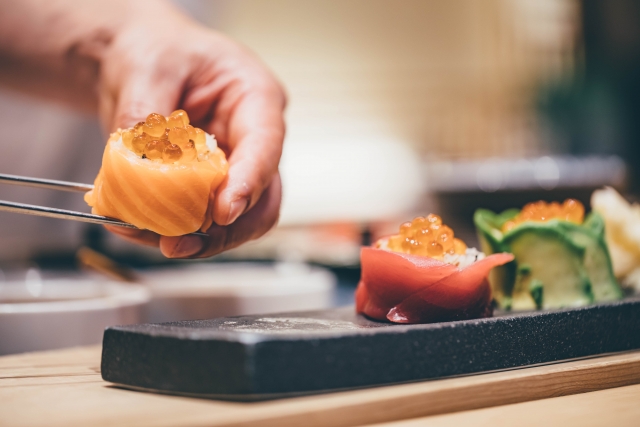食事の時に必ず行うアレの方法を英語で説明してみよう!
箸の使い方を説明しよう!

Hold one chopstick with the index finger, the middle finger and the thumb, in the same manner as when you hold a pencil.
鉛筆を持つときと同じように、一本の箸を人差し指、中指、親指で持つ。
Move the chopstick as you would to write. This chopstick will be the upper one.
箸で1を書くように動かしてみる。これが上側の箸となる。
Put the other chopstick between the bottom of the thumb and the tip of the ring finger.
もう一本の箸を親指の付け根と薬指の先に差し入れる。
The lower chopstick should remain still and you should only move the upper chopstick when you pick up food.
下の箸は動かさず、食べ物をつかむときだけ上の箸を動かす。
回転寿司で説明しよう!

You can pick any sushi you like from a rotating conveyor belt.
回転するコンベヤーに乗っている好きな寿司を取ることができます。
Please take sushi with its plate.
お寿司は皿ごと取ってください。
Once you get sushi, you can’t put it back.
一度手にとった寿司は戻してはいけません。
The prices very depending on the colors of dish.
寿司の値段は、お皿の色によって違います。
“Gari” is a sliced ginger prepared in vinegar. We eat it with sushi.
“ガリ”はスライスしたショウガをお酢に漬けた物です。寿司と一緒に食べます。
「頂きます」「ごちそうさま」を説明しよう!

“Itadakimasu” is a universal phrase which is said before a meal in Japan. The core of the phrase, “itadaku”, is the very polite form of saying ‘to take’, and is used when taking something from someone that is of a higher position than you.
「いただきます」は日本で食事をする前に言う一般的なフレーズです。「いただく」は、’to take’のとても丁寧に言った形です。そして、目上の人から何かをもらった時に使います。
“Gochisousama” means ‘thank you for the feast / great meal’. You can also say “Gochisousamadeshita” with the additional “deshita” on the end, too, to make it polite. This phrase again shows your appreciation towards the people who have prepared the food.
「ごちそうさま」は食事に対する感謝を意味します。また、「ごちそうさまでした」と言うこともあり、「でした」を最後に付けることでより丁寧になります。これは食事を用意して下さった方に改めて感謝を示すフレーズです。
